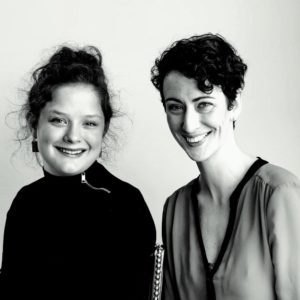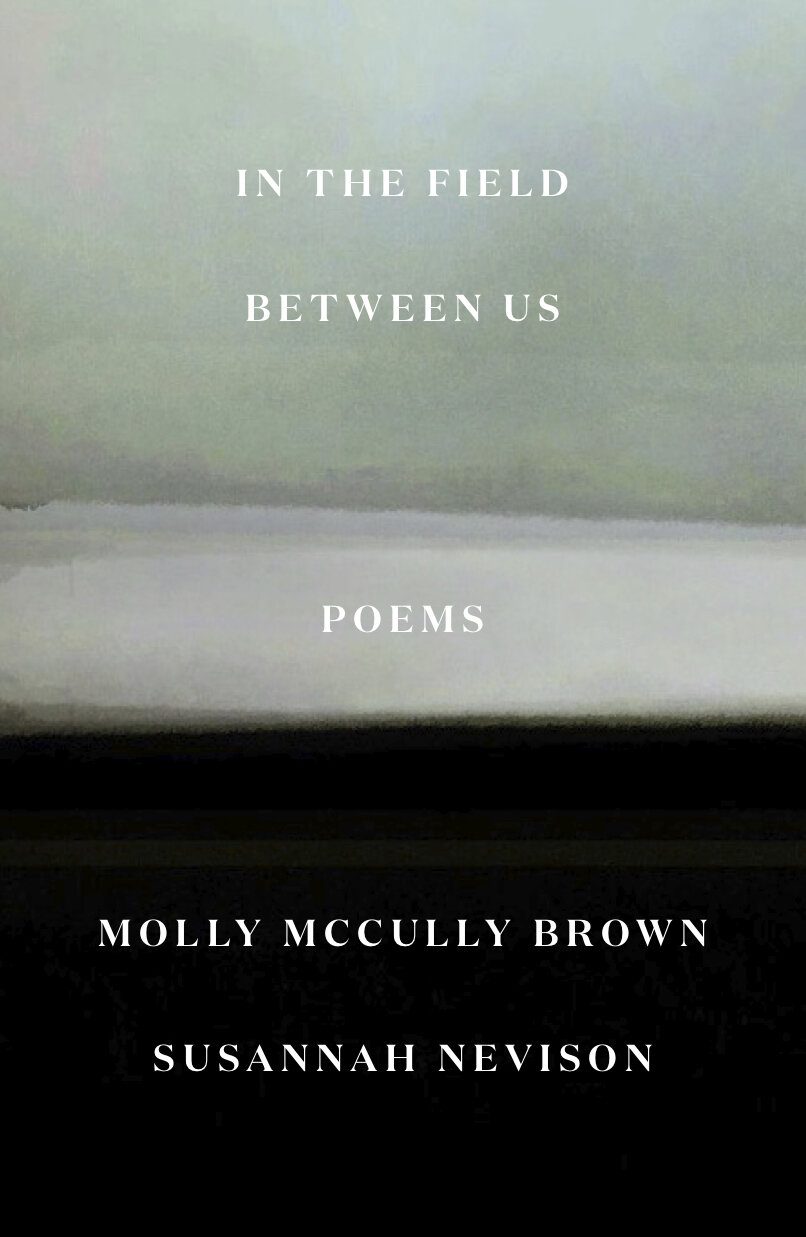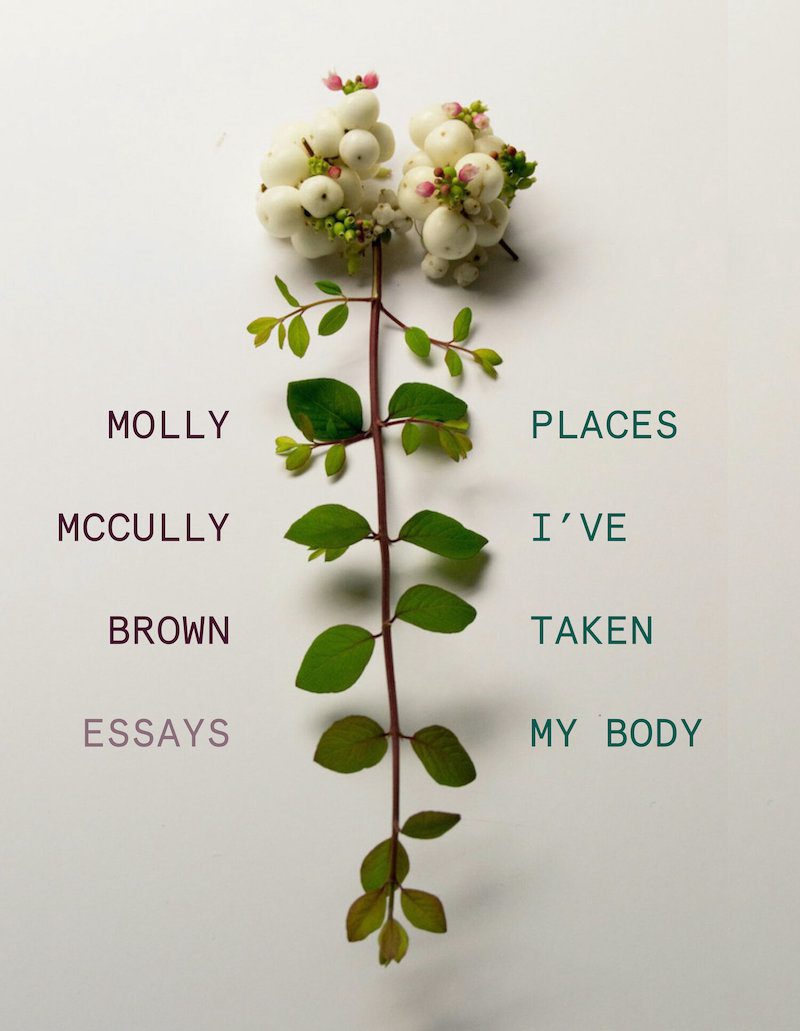
I first heard about Molly McCully Brown’s work from a writer-friend last fall, after a year of much injury and illness. “You should interview her,” my friend told me. “She writes a lot about bodies and disability. Plus, you won’t be scared to talk to her about the God stuff.”
Brown teaches at Kenyon College, where she is the Kenyon Review Fellow in Poetry. Her collection of essays, Places I’ve Taken My Body, as well as a collaborative book of poetry created with writer Susannah Nevison, In the Field Between Us, will both be published by Persea Books in June. Both books deal with issues of loss, bodies, illness, friendship, ghosts, and religion. They ask questions about access, about honesty, about the spaces between two people and between versions of ourselves. Parts of each have been previously published in the New York Times, the Paris Review, Tin House, Oxford American, and here at The Rumpus.
Brown’s first collection was The Virginia State Colony For Epileptics and Feebleminded (Persea Books, 2017), which was named a New York Times Critics’ Top Book of 2017. Co-author Susannah Nevison is the author of Lethal Theater (Ohio State University Press, 2019), and Teratology (Persea Books, 2015). She is an Assistant Professor of English and Creative Writing at Sweet Briar College. Both authors won the Lexi Rudnitsky First Book Prize.
Brown, Nevison, and I spoke about refusing to translate for an imagined reader, the role of God and grief in each of the books, and profound intimacy, both on and off the page.
***
The Rumpus: I’m curious about the force of friendship in the books, both as a theme of the poems and also in the writing process itself.
Molly McCully Brown: The material that In the Field Between Us deals with is lifelong, significant, relatively violent medical intervention. It’s an experience that one has to go through alone. It’s inherently singular and alienating. It divides you from other people in the world and from prior versions of yourself. What was remarkable about meeting Susannah is that because we shared these experiences and an incredibly similar perspective as writers, this thing which had only ever been a source of isolation and the creation of distance in my life, became a source for one of my most profoundly intimate relationships, all of a sudden.
The epistolary form allows the text to navigate this painful, lonely space with an immense amount of company and intimacy. Every time a voice calls, there’s an answering voice. That’s the reason we had to end the book the way we did, with a braided letter with no addressee. We couldn’t end the book with one voice. It would be like the other voice just stopped answering in the wilderness. And that’s the opposite of the point. As difficult a book as it is, it’s not a sad book, because of friendship.
Susannah Nevison: Meeting Molly, there was suddenly this whole radically different understanding of what friendship and emotional support could look like, as well as intimacy and kinship. I had never had a friend I could so easily speak to about the history of my body—the traumas, of having had surgery since I was five months old, or what that does to identity and subjectivity—ever.
One of the lovely things about close friends is that feeling of not having to explain yourself. But for us this feeling has to do explicitly with disability. It’s a level of freedom that most of us disabled people don’t get with anyone else. You’re having to navigate the space between your body and the world around you for everyone else, always. What was so rare about our friendship is that there was never the need to translate that. In the book, we render a space that is made for one, a space for two, or three, or more.
Rumpus: I would love to know about the origin story for In the Field Between Us.
Brown: Susannah and I met at the Sewanee Writers’ Conference one summer. Our friendship has always occurred at a geographic distance because we lived in different states, but it immediately had this level of intimacy to it. Sus and I probably had known each other for about six hours before we started joking about how we should write a book together.
Nevison: Only a couple months after we got back from Sewanee, we wrote essays in conversation together for the New York Times’s disability series. They didn’t get published for another year and a half, but we’d started having written conversations about these issues almost since we met.
Later on, essentially we both arrived at this point in our writing where we didn’t really want to be doing what we were supposed to be doing. We decided that we’d do a collaborative project, just as something for us to look forward to, along with our other work.
Rumpus: What was the editing process like for a collaborative book?
Brown: It’s interesting—because of the way the poems were conceived, if we cut a letter from one of us, then we had to cut the corresponding letter, or we had to figure out something to put in its place. Sometimes we had a negotiation where one of us had written a poem that we really hated; we’d like the other person’s corresponding poem but not our own. I love Susannah’s work and don’t have the same ego-filled relationship to it, so I was sometimes more allowing with my own work to save something that I really admired of Susannah’s. It allowed me to feel affectionate about the revision process in a way I’d never feel about revising my own work alone.
We did cut some poems from when we were writing our way in. The poems in the book appear roughly chronologically as they were written.
Nevison: The first poem in the book is the first one that we wrote. We each edited the whole manuscript, so I got to provide line edits for poems that I admired; revision became this act of joy.
Rumpus: Are there other books that you see this one in conversation with?
Nevison: When we began publishing these, Ada Limón and Natalie Diaz started publishing a series of letter poems, epistles, that also have a lot to do with kinship and friendship and geographical distance. So these are probably in conversation with those.
But otherwise, this felt like a book we needed to create because we couldn’t find this conversation anywhere else. And if it does exist somewhere else, I don’t know about it and that’s maybe my failing but also the publishing industry’s failing.
Brown: I would say that’s the culture’s failing. For a long time when we were writing these poems, we initially weren’t envisioning that they’d necessarily ever see the world. We just loved it and wanted to try it. As Susannah said, we were also avoiding other parts of our writing lives that felt less full of joy. [Laughs.] But we really weren’t sure if we were producing anything that was going to have a public life. We created this book with very little consciousness for how it was going to fit into the literary landscape. Obviously it’s been this huge, colossal joy that they’re now going to be in the world but it was already a huge, colossal joy when it was just shared between us.
Rumpus: How did you hold the idea of being read by people who we could call temporarily able-bodied?
Brown: One of the gifts of the book is that for a really long time I didn’t think about that. The book was designed explicitly to see if we could write a book in which we do literally no translating for an able-bodied audience, a book in which we don’t engage in the acts of making our experiences and lives and bodies legible for able-bodied people. What would it mean to, instead, try to make transparent what the intimacy of not doing that translation looked like? Just to let the natural, intimate logic of our friendship and our lives be the guiding post.
One of the biggest gifts has been seeing the ways in which it has felt meaningful for readers to come in and encounter that space and world, even without holding a lot of consciousness for a long time about being read.
Nevison: I thought, pardon my language, but: Fuck it, we can write this, and if it’s hard or inaccessible then that’s just how it is. The poet Jillian Weise always says there’s no such thing as a non-disabled audience, because bodies are fluid and because of the fact that one in four Americans does identify as disabled.
We were tired of explanation or translation. This is a project about what happens when we don’t do any of that. And the ways that that, too, is accessible to people. That, too, is a valid mode of communication and expression and language. Hopefully people can find their way in, and can see that maybe not everything has to be translated and explained to be valuable.
Brown: It’s also funny to use the word “inaccessible,” which we do when we talk about writing that’s difficult. After having necessarily spent so much of our lives on the margins and not being the assumed audience, it was a way of being like: Fuck it, this time the center’s over here. We’ve moved where the center is! And that in and of itself felt really empowering. It doesn’t have signposts for you if you’re a reader where this is not your reality, because this is our world. So much of the time, the world that we actually inhabit is decidedly not our world and not made for us.
Rumpus: How did the structure of the poetry collection come to be? I’m curious about the decision to go “backwards” in time in the book, if we’re believing in linear time in this interview.
Nevison: It goes backwards in time because that’s the way our access to these events works. My earliest memory, Molly’s earliest memory, are of those moments before you go under, are of some sort of obliteration of selfhood. Part of what we both struggle with, and are interested in, is working back towards an understanding of self that predates that, an original self. We have to work our way back through surgery—through those erasures, through all the opening and closing of the body—to get there. So the book became about a communal refiguring of what our history is.
Brown: The structure allows the book to work in two directions simultaneously. In some ways it does start with birth—those two very early poems talk explicitly about being born. But then the book also works in the opposite direction because of the ways the sections are structured. We begin in the aftermath. That’s how it is to be alive. You’re both moving through linear time and also recollecting in memory.
Nevison: As soon as you arrive somewhere, you’re also simultaneously leaving somewhere else. That’s especially true of bodies that have experienced pain and suffering and ongoing medical intervention. As soon as you become comfortable in one form, it gives way to another. If I could make the book a circle, I would. It has to be linear because that’s the form of books.
Brown: It literally does go in a circle. The book is full of endings and re-beginnings, of moments where something transforms. Which is also about the reality of living in bodies that are being constantly revised. You can’t get back to the true thing, the real beginning and the moment before the rupture and the rending, but also, you are forever beginning again. The book enacts that.
Rumpus: This was more explicitly on the page in the essay collection, but I’m wondering what it was like for you, Molly, to talk publicly about being a person who has a relationship with God.
Brown: I resisted calling myself a religious person for a really long time. I talk about this explicitly in one of the essays, but I did a lot of distancing myself in the way that academics are so good at. Being like: I’m interested in the idea of this; this is a compelling thing to me, abstractly. As opposed to: This is a thing that I feel, or a conviction I have. Academics love critical distance. It’s the best!
I also grew up in this part of Virginia which is the heartland of fundamentalist Southern Baptism. Liberty University is twenty-five minutes from where I grew up. Jerry Falwell is being a fucking asshole and bringing people back to camp, even in the middle of this global pandemic. For a long time that was what being a religious person looked like in my experience. I wanted to stay as far from that as humanly possible.
I was an intellectual, raised in a household of intellectuals. There wasn’t a rational explanation for why I believed in God. So it took me a long time to get to a place where I could talk about it. I didn’t pick it—I maybe would not have picked it—but it’s also a true force in my life. And because I’m a writer, it’s a thing I felt like I had to figure out how to write about and give language to.
Like Susannah says, she’s not a person who believes in God and thinks about it in that same way, so in some ways I dragged her kicking and screaming into that territory in our book. But one of the things I love about the poems addressed to “Maker” is that the sense of who the Maker is is so expansive. There’s room for a Maker figure who is divine, a kind of God-like figure. But the Maker is also a doctor, a surgeon, and the Maker is also an artist. There’s the presence of a lot of multiplicity and doubt and resistance.
Even though now I call myself a religious person, a conflicted but deeply devoted Catholic, my relationship with faith still feels complicated and full of resistance and like it’s always changing. I love the space that I hope both books make for that kind of engagement.
Rumpus: How did you think about the role of grief within each of these works?
Nevison: One of the things I’m constantly asked, and I think Molly is too, after some sort of medical intervention, is, “Is it better? Are you better?” As if the narrative of the body is that there’s a problem and then it gets fixed and everyone feels better psychologically and physically. There isn’t a lot of space for grieving along the way. Which isn’t to say I’m not incredibly thankful for surgical intervention. In a pretty major way, I’m quite thankful. But it still is a process of letting go, even if it’s a thing that caused you pain. It’s still a part of yourself. You have to become acquainted with a new version, to confront what was taken from you, things you didn’t know you were giving up but you were giving them up. There was no way to write this book without acknowledging that grief. A big part of the intimacy of our friendship is that there’s always space for that. There’s never a point at which, if I were going through surgery, Molly would be like, “Okay, are you better now?”
Brown: Absolutely. The medical model of disability says: This is a thing that’s wrong with your body or your brain, and we can do various things to repair, to some extent, certain errors. Like Susannah, I’m incredibly grateful for the medical intervention that’s happened in my life. I’m as mobile as I am because of it. But the medical model doesn’t make a lot of room for that as also being inherently violent. And conversely, in some other models, like the social model, you’re supposed to think about disability as this empowering thing, this identity you’re proud to have. It isn’t something that’s wrong with your body but an error in the world and in the way it makes space for your body. That model also doesn’t make a lot of room for grieving or loss. I still wish I wasn’t in pain all the time. There’s sorrow here, there’s difficulty.
I spend a lot of time feeling anything else besides grief. I think that’s clear in the essay collection. Who wants to feel grief? It blows. Susannah is one of the first people, other than maybe a therapist, to whom I ever said, “I feel really sad about this. This is really hard and the grief isn’t going anywhere and it’s never, in some ways, going to go anywhere. It’s just about figuring out how to manage it and have a relationship to it and live with it.” Our friendship was one of the first universes in which I learned to acknowledge, articulate, and live with grief.
The essay collection asks: How do I name that grief in a larger way? How do I learn to live with it instead of running from it? How do I literally just stay where I am? And how do I not let it cancel out everything else that is true? Which is that I love many things about my life and it’s full of a lot of joy. I love many things about my body and I feel very lucky, very grateful. And also there’s a lot of grief. How do you live in those simultaneous realities?
Nevison: We spend a lot of time telling each other both things are true. It’s okay to be angry and upset and sad and to know that what made that grief possible also made joy possible. We are constantly giving permission to each other to feel that there’s room for all of it.
***
Photograph of Molly McCully Brown and Susannah Nevison by Medford Taylor.






